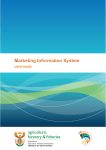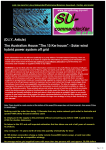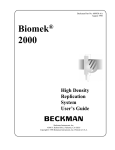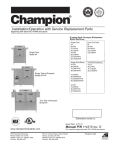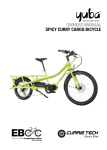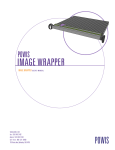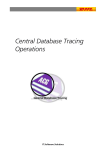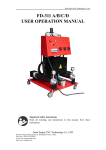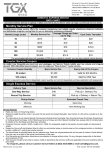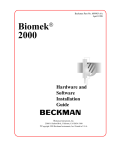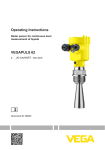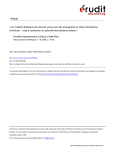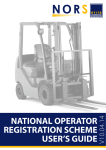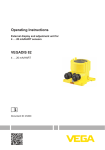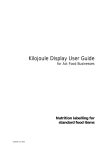Download new importers & exporters
Transcript
new importers & exporters INFORMATION PACK Contents WHAT IS INTERNATIONAL TRADE AND INTERNATIONAL TERMS OF TRADE P3 NEW IMPORTER GUIDE P5 NEW EXPORTER GUIDE P7 EXPORT CONCESSIONS P8 WINE EQUALISATION TAX P10 CHINA SUPPLIER NEGOTIATIONS P11 COMMON TERMS P13 AUSTRALIAN CUSTOMS & DAFF CHARGES P15 ACCOUNTSP18 TRANSPORT TERMS P18 THINGS TO CONSIDER WHEN WORKING ON INDICATIVE COSTING P19 HOW AIRFREIGHT IS CUBED OUT ON BOTH IMPORT AND EXPORT P20 EXAMPLES OF DUTY AND GST FORMULA P21 IN SUMMARY P21 ONGOING FREIGHT ANALYSIS P22 2 STOCKWELL INTERNATIONAL Note from Sales & Marketing If you are reading this booklet you are considering either importing or exporting and entering into the world of international trade. There are various implications, complications, restrictions and considerations that you need to be aware of before beginning this process. There will be no way to cover all of them in one booklet, however, as a guide I consider the What is International Trade and International Terms of Trade International trade is not much different to domestic trade, it still involves a buyer and a seller and the motivation to on sell those products for a profit. The main difference however is that international trade is typically more costly than domestic trade. The reason is that a border typically imposes additional costs such as duty, other taxes, tariffs and time costs due to border delays. Further additional costs can also be associated within the destination country, at ports and final delivery destination. information held in this booklet to be the most So, when dealing in international trade and the important. This information has been collated from complications surrounding different countries how is relevant websites, senior staff and my own the importer and or exporter protected? experiences. Please note we recommend you do Who organises what to get the goods moving? your own research and not use this booklet solely as How do I even start? your source of information. You start with a thorough understanding of the Good Luck! International Commercial Terms (more commonly known as Inco Terms or Terms of Trade); which are a set of pre-defined commercial terms published by the International Chamber of Commerce (ICC). These Angela Gambell three-letter trade terms relate to common international contractual sales practices. They are a series of rules, intended to primarily and clearly communicate the tasks, costs and risks associated with the transportation and final delivery of goods sold internationally. They clearly define who is responsible and where the risk transfers from seller to buyer. The Incoterms/rules are accepted by governments, legal authorities, and freight practitioners worldwide. They are intended to reduce or remove altogether uncertainties arising from different interpretation of the rules in different countries. As such they are regularly incorporated into sales contracts. When discussing International Terms of Trade in the initial phase of your intended international purchase, the supplier will generally let you know what particular term they sell under. On the following page you will find a chart that clearly defines who is responsible for certain tasks along the supply chain for different terms of trade. STOCKWELL INTERNATIONAL 3 SHIPPING INCO TERMS CHART Obligations under term EXW FCA FAS FOB CFR CIF CPT CIP DES DEQ DAP DDP EXW Inland freight at origin; from factory to the carrier or frontier B S S S S S S S S S S S Export customs clearance and export documentation B S S S S S S S S S S S Payment of customs charges and taxes at origin B S S S S S S S S S S S Loading to the main carrier and port charges at origin B S B S S S S S S S S S Main carriage/freight B B B B S S S S S S S S Cargo (marine) insurance B B B B B S B S B B S S Unloading from the main carrier and port charges at destination B B B B S S S S B S S S Customs clearance at destination B B B B B B B B B S B S Payment of customs duties and taxes at destination B B B B B B B B B S B S Cartage from port / carrier to Buyer at destination B B B B B B S S B B S S Other costs and risks at destination B B B B B B B B B B S S ABBREVIATION MEANINGS B = Buyer S = Seller EXW = Ex Works CIP = Carriage and Insurance Paid To FCA = Free Carrier DAF = Delivered At Frontier FAS = Free Alongside Ship DES = Delivered Ex Ship FOB = Free On Board DEQ = Delivered Ex Quay CFR = Cost and Freight DAP = Delivered At Place CIF = Cost, Insurance and Freight DDP = Delivered Duty Paid CPT = Carriage Paid To Marine Insurance is the responsibility of the importer except under CIF & CIP - Stockwell’s now offer Marine Insurance 4 STOCKWELL INTERNATIONAL New Importer Guide Now that you have a good grasp of international trade and the International Terms of Trade it is now time to progress discussions with your intended supplier of goods; following is a quick guide to this process. Source a reputable supplier/s who allows you to export on your terms. Those terms usually being FOB from most countries. That is you have more control over who ships your goods and how much you pay for freight and port charges in Australia. (FOB – you take responsibility of your goods from the Ships rail in the country of origin to your door). Under FOB you will be required to obtain your own Marine Insurance broker, or we can give you the details of our broker. Alternatively most insurance companies such as your own home and contents insurer can offer you marine insurance, you just have to ask. Make sure all the necessary paperwork rules and regulations for your commodity are both understood by yourself, and your supplier. This ensures smooth clearance in Australia, and limits any delays through customs and quarantine. All wooden packaging and or products must be treated and documented in accordance with DAFF requirements prior to entry into Australia. Don’t trust your supplier will understand DAFF requirements, make it clear to them, especially if your goods are lacquered or painted. Treatment needs to be done prior to this application. Stockwell International will liaise with your supplier to organize your freight STANDARD PAPERWORK REQUIREMENTS (Importers responsibility to assist chasing) An original Bill of Lading (or Telex / Express release) Commercial Invoice VARIATIONS TO STANDARD PAPERWORK Hazardous Goods (MSDS Required) Food Stuffs (Import permits required) Motor Vehicle (Import permits required) Packing List Treatment Certificate (with a numerical link to your shipment) Paperwork to be given to Stockwell’s in preparation to clear your goods through customs. Quarantine Packing Declaration You will receive an ETA for your goods, along with vessel information, which will be followed up by Stockwell International staff. Once your goods have arrived into Australia you can expect release (sea freight) of your LCL (less than a container load) cargo in around 5-7 days, and FCL (full container load) within 3 days. Airfreight is generally released shortly after arrival (1-2 days). Payment of Freight, duties and GST is expected before release of goods. Transport to your door can be arranged via yourself or by Stockwell International. You may only have your full container for 7 days from the arrival of the vessel, not when the stevedores make the container available to the freight forwarder. Be sure to get it unpacked and returned ASAP to avoid further costs in detention/demurrage. STOCKWELL INTERNATIONAL 5 IMPORT REGULATIONS TO CONSIDER If you are interested in either the import or export of So you have now located a reputable international both imports and exports. supplier and have discussed the intended International Shipping Terms. You now need to understand what sort of restrictions, licences, permits or quarantine issues are associated with your product. For information on restrictions on imports or fumigation go to www.daff.gov.au. All wooden/bark/ dunnage materials, pallets or packaging need to be treated prior to import into Australia. For information on customs issues such as duties go to www.customs.gov.au. But as a general guide wine please visit www.wineaustralia.com for further information. There are restrictions on this product for If you are interested in the exportation of meat please visit www.daff.gov.au/aqis/export/meat for restrictions on these products, including permit and other related matters. If you are an overseas company and want to distribute within Australia directly you will need to visit www.business.qld.gov.au/smartlicence or visit the following link http://www.asic.gov.au/asic/asic.nsf/ byheadline/Foreign+Companies?opendocument#who most products are 5%, apparel is 10% and alcohol IMPORTANT NOTE: As an importer, it is your and tobacco are higher and also have different responsibility to understand the requirements of taxes applied. your own products. Most new importers are hit with If you are importing a vehicle for use on Australian roads you will require licences and permits, please go to www.infrastructure.gov.au to find out what you will need prior to import (vehicles include motor cars, motor bikes, trucks, boat trailers, caravans). To assist with working out your duties, you can visit www.dutycalculator.com. Don’t forget in your additional charges at destination due to their lack of knowledge. Additional charges can be in the form of Wharf Storage (charged by the stevedores) when cargo remains on the port waiting for paperwork for clearance; fumigation when incorrect treatment has been done or not done at all or done prior to painting/ lacquering; container detention/demurrage when you have the container longer than the shipping line allows, to name a few. calculations that you are also charged import GST. If you are importing a commodity that will be used by the general public or children you will have to meet Australian Standards and you can find out about your product requirements by emailing [email protected] or visit www.standards.org.au Now that you have all the information about your particular product, you are ready to begin negotiations with your supplier regarding the international movement of your cargo. for further information. If you are importing goods that will be consumed by the Australian public you will need to ensure that those products meet Australian food standards and they may require permits/licences as well. Please visit www.foodstandards.gov.au for further information. 6 STOCKWELL INTERNATIONAL New Exporter Guide Source a reputable buyer of your product and negotiate your payment and shipping terms. Make sure all the necessary paperwork for your commodity is understood by yourself and the buyer or customer. This ensures smooth export from Australia, and limits any delays through customs in the destination country. You need to know the import regulations in the country you are exporting to. STOCKWELLSWILLASSISTTOORGANISE YOUR SHIPPING You will supply a commercial Invoice Packing List VARIATIONS TO STANDARD PAPERWORK Hazardous goods Food stuffs/Meat Motor Vehicle Fumigation Certificate Quarantine Packing Declaration Alcohol/Spirits Paperwork to be given to Stockwell’s in preparation to clear your goods through customs. Please make sure you know if permits or specialised paperwork is required for your export You will receive an ETD for your goods, along with vessel information, which will be followed up by Stockwell International staff. You are more likely to have a better outcome with your export, if you leave the customs details to your buyer. In other words you are better off to sell your goods CIF. EXPORT TIP Certain commodities leaving our shores will need of destination at your cost. A permit organised after the goods have left the country will not be accepted. permits to exit the country as already discussed, you Every country has different laws; it is your job as will need to have any permits in place prior to the the exporter to find out what those laws will be. It goods leaving Australia or the goods will either be is always best to sell your exported goods under returned back to Australia or destroyed at the country CIF/CFR terms’, which leaves all the duties and tax implications to the buyer in the country of destination. 7STOCKWELL INTERNATIONAL 7 Export Concessions How long do I have to lodge a claim for Duty DUTY DRAWBACK SCHEME For goods exported on or after 21 October 2006, Customs has a number or assistance schemes exported or within a four (4) year period from that available for Australian industry operating in overseas markets. The Duty Drawback Scheme enables exporters to obtain a refund of Customs duty paid on imported goods where those goods will be treated, processed, or incorporated in other goods for export; or are exported unused since im-portation. Who can claim Drawback? Only the person who is the legal owner of goods at the time the goods are exported, or a person to whom this right has been assigned, is eligible to make a claim for Duty Drawback. Drawback? claims can be lodged on the day the goods were date. (Please note goods exported prior to 21 October 2006 are subject to a 12-month time limit for claims). What is the minimum amount I can claim for Duty Drawback? The minimum claim per application for duty drawback is A $100. Requirements to lodge a claim You must: ⁄ Register your Australian Business Number with Can a refund of GST be claimed using Duty Customs or obtain a Customs Client Identifier Drawback? (CCID); There is no refund of GST through the Duty ⁄ Drawbacks Scheme. What goods are eligible for Duty Drawback? Obtain an Export Declaration Number (EDN) for every line on the Claim for Drawback; and ⁄ Provide your bank details when completing the Duty drawback is available on most goods on which drawback claim form or lodging electronically into customs duty was paid on importation and which has the Integrated Cargo System. been exported. What goods are not eligible for duty Drawback? Duty drawback can’t be claimed where: ⁄ return by fax or mail. the purposes of inspection, exhibition, processing, From 23 March 2010, drawback claims can be treatment or further manufacture (i.e. goods lodged electronically via the ICS (Customs Interactive can’t be claimed if used in the filtration or as (CI) only). product) ⁄ Complete a Claim for Drawback form (B807) and Goods have been used in Australia other than for manufacturing machinery of further manufactured ⁄ How do I claim a duty Drawback? Those who are first time users to the ICS should access the following link for further information on Goods are valued at exportation at less than 25 per how to communicate electronically: cent of their imported customs value; or http://www.cargosupport.gov.au/site/page5952.asp The import duty paid on the goods has been A user manual is available to assist those lodging refunded. claim electionically. The Drawbacks manual can be found at: Can I apply for a duty drawback on tobacco products that do not meet plain packaging requirements? Yes. More information can be found on the tobacco refunds/drawbacks page. 8 http://www.cargosupport.gov.au/webdata /resources/files ExportConcessionsDutyDrawbackScheme Nov2012.pdf STOCKWELL INTERNATIONAL Who can I contact about the Duty Drawback Scheme or about lodging a claim for Duty Drawback? For information on Duty Drawbacks, contact Customs on 1300304322 Monday to Friday between 8:30am to 5pm (Eastern Standard time) or email: [email protected] The processing of duty Drawback claims is carried out by Customs in Melbourne. Claims may be faxed to (03) 9244 8440 or mailed to: Drawback Section Trade Services Branch Australian Customs Service GPO Box 2809AA Melbourne Victoria 3001 Please note that this information is intended as a guide only. Full details on the operation of the Duty Drawback Scheme are contained in the Customs Act and associated regulations. Who can I contact about claiming a drawback of Excise Duty? For information on drawback of excise duty, please contact the Tax Office on 132 478. STOCKWELL INTERNATIONAL 9 Wine Equalisation Tax KEY FEATURES OF WET EXAMPLE CALCULATION OF WET Imported wine is subject to wine equalisation tax Wine Supplies $100 WET (29%) $29.00 WET Inclusive Price $129.00 GST (10%) $12.90 Total $141.90 information as follows: ⁄ The WET tax rate is 29% ⁄ Wet is paid to the Australian Taxation Office (ATO) or The Australian Customs Service (Customs) by wine manufacturers, wine wholesalers and wine importers. ⁄ WET is normally included in the purchase price of wine when supplied to retailers such as bottle shops, hotels, restaurants and cafes. However, if a retailer on-sells (acts as a wine reseller) then WET also applies in this case. ⁄ WET does not apply to exports of wine. ⁄ WET is levied on wholesale transactions. The tax is calculated on the last wholesale price. 10 STOCKWELL INTERNATIONAL China Supplier Negotiations This part of the process forms the basis to the rest ⁄ I usually instruct my clients on at least 40% up of your movements and involvement with freight front (depending on the value of their goods) forwarders and other logistics companies. Do this 20% once the goods have been made and a incorrectly and you could be the proud owner photo supplied, then 40% once goods have been of goods you never ordered in the first place, or received in Australia. When a relationship is being worse the person responsible for paying all debts formed based on payment terms you need to ask associated with the import, whether they were what if they are also willing to do a Letter of Credit for you expected or not. the first couple of shipments. Letter of Credit puts the ownership of the goods with your supplier’s When dealing in China it is imperative you form some bank and your own bank. Once the goods have sort of relationship whether this be by a very worthy been received and the final payment made, trip over, or a factory audit and some sort of due the bank will release the Bill of Lading and the diligence. Of course if you are a smaller importer ownership goes back to you. these things may be out of your budget, so be wise and ask a few very important questions. ⁄ ⁄ freight, as they sometimes receive kick backs in Do you currently export goods to Australia? If so the form of discounted shipping rates that they can you give me any names for referral purposes? ⁄ ⁄ The supplier will also want to organise your will never pass onto you. Out of China I would Are you able to organise your own export recommend nothing but FOB terms. USA is paperwork, including any fumigation requirements I Exworks only. Everywhere else is either Ex Works need for import into Australia? or CIF (or its equivalent). Should a potential supplier want complete payment ⁄ You will always have to weigh up the term being upfront, and not be willing to negotiate, I suggest offered to you with your overall freight costs in you go elsewhere. A willingness to stagger the Australia, sometimes a good freight deal overseas payment suggests they are willing to negotiate and is not so good in Australia because of the shipping at least be good on their word and deliver goods lines associated charges here. Also most people as specified. choose CIF, DAP, and DDP purely for the perceived lack of work involved for them. ⁄ When exporting your goods to an unknown buyer, I would suggest putting all costs associated (including freight and any export charges) on the one invoice with the goods and get payment before exporting. STOCKWELL INTERNATIONAL 11 MORE ON QUALITY ASSURANCE AND DUE DILIGENCE Having your products inspected in China before they leave the factory gives you greater control over your goods. Our audits include but are not limited to full factory audits, in-production inspection, final article Stockwell International can order these all through out China for a price on application. General guide on cost for inspections are as follows; 1. Final article inspection $799 2. In production inspection $799 inspection, container loading supervision and social 3. Container loading inspection $799 compliance audit. 4. Factory Audit $1200 With an inspection on large new orders, importers Depending on location of factory and detail of QC will feel reassured that the products they’ve ordered report required these charges may vary. will meet their expectations. When paying for a QA or Due Diligence inspection you will receive a full report (including photo’s) in less than 48hrs giving you both control and peace of mind. 12 STOCKWELL INTERNATIONAL Common Terms DAFF (formerly AQIS) ETA Department of Agriculture, Fisheries and Forestry - Estimated Time of Arrival – indicates the estimation of a government body protecting Australia from the date/hour, the carrier believes the cargo, vessel contaminated fauna and flora. or container will arrive at a nominated point/port. BAF ETD Bunker Adjustment Factor - adjusts the freight to Estimated Time of Departure – see above. reflect current cost of bunkers (fuel for ships). B/L FCL Full Container Load – an arrangement whereby the Bill of Lading – acts as a receipt for the cargo and shipper utilises all the space in a container which he contains the terms of the contract of carriage and is a packs himself. document of title to the goods. Cartage GP General Purpose – a closed steel container for the Refers to the intra-city haulage of goods on drays carriage of all types of general, non-hazardous cargo. (heavy side less cart) or trucks. 20’ & 40’ available in GP. Consignee (CNEE) GST The party to whom a consignment is dispatched, Goods and Service Tax – worked out as 10% of the having legal title to the goods. CIF value + the duty amount. The CIF value is the Consignor (CNOR) The sender of the goods Detention/Demurrage cost of goods + marine insurance + freight amount (cost to get cargo to destination port) + duty. House Bill of Lading Issued by a freight forwarder or consolidator covering 7 to 10 days (depending on the shipping line) to get a single shipment containing the names, addresses the container off the wharf, and returned to the empty and specific description of the goods shipped. container yard. Otherwise the client will be charged on a daily basis for extended hire of the container. D/O LCL Less than Container Load – when a parcel is too small to fill a container, it is grouped by the carrier at A document given to the party surrendering the original a ‘CFS’ depot, with other compatible cargo, for the Bill of Lading, authorizing them to take delivery of same destination. the goods. Duty Packing List Document required by the buyer and Customs, Is a particular percentage (depending on commodity) indicating content being shipped, or contents of of the FOB value, which is paid to the government. each package. The FOB value is the cost of the goods plus any other charges to get those goods on to a vessel. STOCKWELL INTERNATIONAL 13 STOCKWELL INTERNATIONAL 13 Packing Declaration TEU Mandatory document required by DAFF which states Twenty-Foot Equivalent Unit – ie. 1 x 20ft = 1 TEU, how the shipment has been packed with regards to 1 x 40ft = 2 TEU. straw, timber and bark. The packing declaration must be completed in full including a numerical link i.e. THC container or bill number and issued on supplier’s own Terminal Handling Charge – a charge for handling letterhead to be accepted by DAFF. containers at ocean terminals/wharves. POD Wharf storage Place of Discharge – the place where the goods For FCL the transport company will have 3 days are discharged and carriers liability ends. It can to pick the container up off the wharf ( only after also mean; Proof of Delivery – a signed receipt the wharf has given an availability to pick up the acknowledging delivery. container). If pick up of container is delayed for POL any reason (such as incorrect paperwork, or no paperwork) additional storage on the wharf is Port of Loading – the port at which accepted cargo is charged. loaded onto a vessel. For LCL, this is different as these goods go to an Reefer unpack depot (after the vessel arrives and avilability A refrigerated container. is given) to unpack and sort out the mixed freight, this can take up to 7 days to become available for pick up, however you then only have around 1-2 days NOTES to arrange pick up of the goods before storage is charged from the unpack depot. 14 STOCKWELL INTERNATIONAL Australian Customs & DAFF Charges All full containers being delivered outside the UNFORSEEN AND UNQUOTABLE CHARGES metropolitan area of the port of destination must Any container entering Australia may be subject to a undergo a quarantine tailgate inspection. That is a random customs hold , they are completely random, DAFF officer (s) opens the container doors . A visual cannot be avoided and no additional charges will be inspection is to verify the integrity of the goods the incurred unless something untoward is found in the packing and the cleanliness of the container. Fees container. The only issue here is a time delay. and charges apply. Occasionally an import is subject to random WHAT IS TAILGATE? paperwork inspection by DAFF and should incorrect information be found an inspection will be necessary, at the importers cost. This will generally relate to misleading or incorrect information supplied on the paperwork that comes with your shipment and/or if they find anything that is not supposed to be in the container. Once your container arrives into Australia you have 3 days to clear the goods, if you do not have the container removed from the port in this time you will be charged storage by the stevedoring company. Delays here can sometimes be from not having correct paperwork or the container is being held by DAFF. You will then also have between 7-10 days to then have the container unpacked and returned to the empty container yard, if the container is late you will then be charged detention by the shipping line. Unfortunately incorrect or late docs will most definitely result in either storage or detention and this will be at the cost of the importer. So it is best to start chasing your supplier for correct information from the beginning. It would also be wise, if the goods are not under a LC (letter of credit) to negotiate an “express release” of your paperwork with your supplier. This means all goods can be released by the freight forwarder or shipping company without the need for an original bill of lading. STOCKWELL INTERNATIONAL 15 OVERSEAS TREATMENTS ⁄ Scrap metal Certain overseas commodities must be treated before ⁄ Foodstuffs, coffee beans they are able to be imported into Australia. These ⁄ Dried or fresh fruit ⁄ Herbs and spices ⁄ Stock foods – plant and animal ⁄ Household and personal effects ⁄ Matting – straw and seagrass ⁄ Dried and fresh plant and plant material ⁄ Unprocessed agricultural produce ⁄ Timber including articles made of timber or that have timber included in the manufacture, such as footwear with wooden heels or wedges ⁄ Articles of straw ⁄ Goods likely to be contaminated – especially with soil and animal and plant material, such as vehicles and machinery. treatments must be DAFF approved, and if they aren’t, DAFF reserves the right to export all goods, destroy, fumigate and/or unpack at the importers cost. Some of the most commonly imported goods that must be inspected and may require import permits; ⁄ Used agricultural machinery ⁄ Used motor vehicles ⁄ Used mining equipment ⁄ Bamboo and straw articles ⁄ Nuts and seeds ⁄ Canned meats ⁄Rice ⁄Cheese NOTES 16 16 STOCKWELL INTERNATIONAL STOCKWELL INTERNATIONAL OFFSHORE TREATMENT PROVIDERS LIST CHINA (Excluding Hong Kong) As at 27 April 2005 All certificates from treatment providers in China must be endorsed by the Entry – Exit Inspection and Quarantine Bureau of the People’s Republic of China (CIQ SA). This endorsement is the CIQ logo in the top left corner of the certificate; the certificate must bear the stamp of the issuing branch. If treatment certificates from China are not endorsed with the CIQ logo they are unacceptable. DAFF does not accept treatment certificates issued by private treatment providers located in Hong Kong for treatments performed in China. Certificates issued by private treatment providers for treatments performed in China are unacceptable. Please note: It is now a requirement to have original fumigation certificates from China as it includes an inbuilt security feature that shows up when photocopied under a certain setting. Certificates must have a numerical link to the shipment or it will be rejected. Treatment certificates from other countries require them to clearly state the treatment used, the date they were treated and if both the packaging and the commodity have been treated. NOTES STOCKWELL INTERNATIONAL 17 Accounts NEW CLIENT OR TRIAL SHIPMENTS EXPORTS For a new client, the first shipments MUST be exporting has begun. This is to ensure we are paid, payment up front regardless. as once the freight is overseas; it is extremely difficult This is until an established relationship with the client is formed. Goods will not be released until payment is made. All payment for exporting must be paid prior to to get payment out of the client. ACCOUNT APPLICATION This to ensure we capture all business information for After a relationship has been established, all DUTY / GST / FREIGHT and OVERSEAS charges must still be paid upfront. customs, as well as for our accounts department. It is also used for general accounting, billing and invoicing purposes, even if payment is upfront, as we Australian landed charges however will be able to be need to record payment for GST and audit purposes. paid in 7 – 10 days. It is not used for applying for any sort of credit terms. We do not offer credit. Transport Terms Detention – 7 to 10 days (depending on the shipping Consolidation – different suppliers in different areas line) to get the container off the wharf, and returned becoming one shipment. It is where the suppliers (or to the empty container yard. Otherwise the client will consignee, depending who is paying for it) will send all be charged on a daily basis (less time for refrigerated shipments to one focal point, and then it is shipped as containers). one shipment. It will then be shipped as an LCL or FCL Storage – 3 days to pick the container off the wharf (after the day of arrival). If it is delayed, charges to the client will then occur. For LCL, this is different, as depending on how big the shipment is. RECOMMENDED ROAD LIMITS other clients goods are packed in the container, and Trailer – 24 ton maximum (inlcuding container weight) the container is not assigned to Stockwell’s. Side loader – 20 ton maximum (inlcuding container weight) Delay at consignee – this mainly occurs when a However, all side loaders to operate safely / and to resist trailer is used. However, it may occur with a side breakage should only carry a maximum 18 – 19 ton. loader. Whenever our trucks are delayed at clients premises we charge this fee after the first hour. STANDARD 20’ STANDARD 40’ HIGH CUBE 40’ INSIDE LENGTH 5.89 m 12.01 m 12.01 m INSIDE WIDTH 2.33 m 2.33 m 2.33 m INSIDE HEIGHT 2.38 m 2.38 m 2.69 m MAX. CARGO 21,727 kg 26,780 kg 26,512 kg 18 STOCKWELL INTERNATIONAL STOCKWELL INTERNATIONAL Things to consider when working on indicative costing ⁄ Importers are required to have permits from time to time and these should be considered prior to import. ⁄ Given that new importers can sometimes have limited cash flow, it is a good idea to consider ⁄ It is advisable if you are committing a large deferring your GST on your imported products, amount of financial resources and time to your this can be arranged by your accountant but more product, you should think about organising a information can be sort at; sole distribution agreement with your overseas http://www.ato.gov.au/businesses/content. supplier, to protect your ideas your product and asp?doc=/content/13193.htm the rights to its ownership in Australia. ⁄ ⁄ Tax and Duties on imported products are worked General info out on the following formula’s Dimentions/Weight - Make sure when providing Duty is a particular % (depending on the dimensions and weight for quotes that you check they commodity) of the FOB Value. The FOB Value is aren’t going to be palletised as this s increases the the cost of the goods, plus any overseas FOB volume/weight,. charges. FOB Charges being any cost to get Transport - Be sure to understand your delivery those goods on to a vessel. Usually if the importer has purchased the goods FOB, they can assume the value on their commercial invoice is the FOB value. Duty is a % of that amount. ⁄ ⁄ requirements. Is delivery to a business or residential address? Is there appropriate access for a container truck or restrictions, such as power lines etc? What type of vehicle is required? A side loader (drops GST is 10% of the combined values of CIF & Duty. container to the ground) or a trailer (container remains The CIF Value is the cost of the goods, the marine on the truck), a HIAB (a small truck or lorry with a insurance (which insures the goods in transit), the one jointed crane attached behind the cab), these are freight amount to get to Australia, then you add all charged differently. Unloading facilities, do you the duty amount. have a forklift, overhead crane or is it hand unload or BAF (which is a fuel charge or what we call driver assist? Bunker Adjustment Factor) and Ocean Freight If the container is very heavy it will have to be sent via rates are volatile and change almost daily, I a standard trailer, with an assisted sideloader which would suggest a 10% - 15% buffer on both as a costs more. precaution. ⁄ Any Quarantine charges such as DAFF inspections or washes are charged at cost, transport to the DAFF inspection site will also be charged. STOCKWELL INTERNATIONAL STOCKWELL INTERNATIONAL 19 How airfreight is cubed out on both import and export When moving goods via airfreight charges are based on weight versus volume, the airline will work out the total cubic measurement, per the following example; My goods weigh 25kgs total and have the following dimensions 40 H x 110W x 80L cms = 0.35 cubic metres 0.35 cubic metres x 167 kgs This is then converted using the following = 58.45 kgs formula So the airline will use the volumed weight to charge you - not the actual. The principle behind this is that 1cbm of airfreight is equal to 167 kgs. You will only be charged on actual when it is greater than the cubed amount. 20 STOCKWELL INTERNATIONAL Examples of duty and GST formulas EXAMPLE – ESTIMATING IMPORT DUTY EXAMPLE – ESTIMATING IMPORT GST Duty Formula: Duty is a particular % (depending GST Formula: Worked out as 10% of the CIF value on the commodity) of the FOB value, the FOB value + the duty amount. The CIF value being the cost being the cost of the goods + any other charges of goods + marine insurance + freight amount to to get those goods onto a vessel once it has been Australia + duty. converted into AUD. Commodity: Commodity: Wooden Bed Frames Commercial Invoice Total (cost of goods FOB value): USD 20,000 Cost of Goods Converted to AUD using 0.82 exchange rate USD 20,000 / 0.82 = AUD 24,390.24 Proposed Duty Rate: 5% Wooden Bed Frames Commercial Invoice Total (cost of goods): USD 20,000 Cost of Goods Converted to AUD using 0.82 exchange rate AUD 24,390.24 Proposed Duty Rate: 5% Duty Chargeable (estimate only): 5% of AUD 24,390.24 = AUD 1,219.51 Duty Chargeable (estimate only): 5% of AUD 24,390.24 = AUD 1,219.51 Import GST Chargeable: Cost of Goods AUD 24,390.24 + Marine Insurance AUD 300.00 + Ocean Freight converted to AUD 2980.00 + Duty AUD 1,219.51 = AUD 28,889.75 10% of AUD 28,889.75 = AUD 2,888.98 In Summary, always think of the following ⁄ Supplier guarantee and/or distributorship ⁄ Product Safety OTHER WAYS WE HELP NEW IMPORTERS ⁄ AQIS requirements We are happy to advertise our new importers to our ⁄ Don’t forget to cost in duty, GST and currency fluctuations ⁄ Fluctuation on freight pricing throughout peak social media networks (e.g. Facebook) to assist you periods of a year with building market awareness. ⁄ Permit requirements ⁄ Cash flow and GST deferral STOCKWELL INTERNATIONAL 21 listed database of current and prospective clients through ‘Our new importer of the Month’ program. We will also promote your new business through our STOCKWELL INTERNATIONAL 21 Ongoing Freight Analysis All international trade involves outside influences which will impact the cost to move cargo throughout the year. To give you an example of how certain things, such as the world economy, consumer confidence, fuel costs and supply and demand affect your pricing, we have graphed the 20’GP Sea freight pricing costs including the fuel component out of China for your interest and consideration. 06-07 China Freight Analysis 1600 1400 1200 1000 800 600 400 200 0 Freight BAF PSS China Freight Analysis 07 - 08 1800 1600 1400 1200 1000 800 600 400 200 0 July Aug Sep Oct Nov Freight 22 Dec Jan BAF Feb Mar April May June PSS STOCKWELL INTERNATIONAL 08-09 Financial Year (GFC) 1200 1000 800 Ave Ocean Freight 600 BAF PSS 400 200 APL MAY MAR FEB JAN DEC NOV SEP OCT AUG JULY JUNE MAY APL 0 09-10 Financial Year (Recovery) 1600 1400 1200 1000 800 Ave Ocean Freight 600 BAF 400 PSS 200 0 STOCKWELL INTERNATIONAL 23 STOCKWELL INTERNATIONAL 23 10-11 Financial Year (Fuel Crisis) 1000 900 800 700 600 500 O/F 400 BAF 300 PSS 200 100 0 11-12 Financial Year (No consumer Confidence) 1000 900 800 700 600 500 2011/2012 Analysis 400 BAF 300 PSS 200 100 0 24 STOCKWELL INTERNATIONAL STOCKWELL INTERNATIONAL 25 www.stockwells.com.au


























